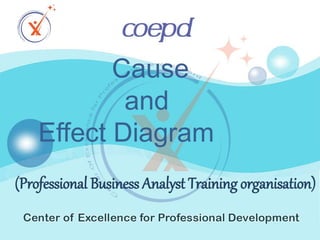
Cause and effect diagram
- 1. Cause and Effect Diagram (Professional Business Analyst Training organisation)
- 2. •Cause and Effect diagram devised by Professor Kaoru Ishikawis also known as Ishikawa diagram or Fishbone diagram. This diagram helps to categorize all possible causes of a specific problem, and identify the reason for a process not working out.
- 3. •This is one of the great visual tools to use during brainstorming session to focus on the conversation and help the group to determine important causes with more detail. The diagram resembles the skeleton of a fish and hence the name ‘Fishbone diagram’ is given.
- 4. Why use Cause and Effect diagram? · Easy to read format to draw out cause and effect relationships in an orderly manner. · Recognizes areas of collecting information. · Increase process knowledge. · Group participation is encouraged to gather data.
- 5. Traditional BA (Waterfall) Agile BA Requirements are documented in Use Cases,Business Requirements, Functional requirements, UI Specifications, Business Rules. Requirements are documented in Epics, User Stories and optionally Business (or Essential) Use cases. Focuses on completeness of requirement and spends time in ensuring the requirement is unambiguous and has all the details. Focuses on understanding the problem and being the domain expert so that s/he can answer questions from the development team swiftly and decisively. Focuses on getting a ‘sign off’ on the requirements. Focuses on ensuring the requirements meet the currentbusiness needs, even if it requires updating them. Often there is a wall between the BA/Business and the Development team. Agile BA (Often called as Product Owner) is part of the team. Tends to dictate solutions. Has to remain in the problem domain, leaving the development team ‘space’ to explore different solutions. Long turnaround. Quick turnaround. Focus on what the requirements document said. In other words, output (Artifact) is a well written thorough requirements document. Focus on the functionality of the developed software. In other words, output (Artifact) is the software that meets thebusiness needs.
- 6. Steps for constructing Cause and Effect diagram · Identify the problem to be analyzed which is the head. · Create a problem box displaying the problem and draw spine (draw horizontal arrow pointing to the right). · Identify the main causes contributing to the problem. These causes are displayed as arrows to the spine similar to the bones of the fish. .
- 7. · Sort out other causes influencing the problem (effect). · Analyze the diagram to determine the root cause. Hence, Cause and Effect diagram drives out all the causes of a problem using the 5 W’s (when, where, why, who, what) to provide an effective solution.
